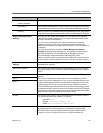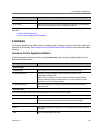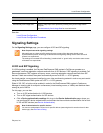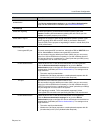
Local Cluster Configuration
Polycom, Inc. 66
See also:
Local Cluster Configuration
Local Cluster Configuration Procedures
Routing Configuration Dialog
In the Network page’s action list, the Routing Configuration command opens the Routing Configuration
dialog, where you can add or delete network routing rules (IPv4, IPv6, or both, depending on the System
IP type setting on the Network page). The Show raw routing configuration button lets you view the
operating system’s underlying routing configuration.
In a split network configuration, routing rules are necessary for proper routing of network traffic. In a
combined network configuration, the operating system’s underlying routing configuration is likely sufficient
unless you need a special rule or rules for your particular network. If you aren’t sure, consult the appropriate
IT staff or network administrator for your organization.
The following table describes the fields in the Routing Configuration dialog. If System IP type is set to
IPv4 + IPv6, the dialog contains two essentially identical sections, one for each IP type. Each section
contains the input fields listed below, a table showing the defined routing rules, and buttons for adding and
deleting routes.
Management DSCP The Differentiated Services Code Point value (0 - 63) to put in the DS field of
IP packet headers on outbound packets associated with management traffic
(including communications to other clusters.
The DSCP value is used to classify packets for quality of service (QoS)
purposes. If you’re not sure what value to use, leave the default of 0.
Default IPv6 gateway The IPv6 gateway’s address and the interface used to access it, generally
eth0, specified as:
<IPv6_address>%eth0
Default IPv4 gateway If management and signaling traffic are on separate networks, select which of
the two networks’ gateway servers is the default.
Your choice depends on your network configuration and routing. Typically,
unless all the endpoints, MCUs, and other devices that communicate with the
system are on the same subnet, you’d select the signaling network.
Note: Route configuration applies to current network settings
You can only configure route settings that are valid for the currently applied settings in Admin > Local
Cluster > Network Settings. If you need to change the network settings and routing configuration,
make and apply the network settings changes first. Keep this in mind if you receive an error when
attempting to change the routing configuration.
Field Description


















